Understanding Autism Spectrum Disorder and Its Neurological Impact
Autism Spectrum Disorder (ASD) is a multifaceted neurodevelopmental condition characterized by challenges in communication, social interaction, and the presence of repetitive behaviors. Recent advances in genetic, molecular, and neuroimaging research have shed light on how autism fundamentally alters brain structure and function across a wide spectrum of neural pathways and regions. This article explores the cutting-edge discoveries illuminating autism's effects on the brain, the underlying genetic and molecular mechanisms, and implications for therapies targeting behavioral and neurological changes.
Genetic Foundations of Autism and Their Impact on Brain Development

What genetic factors contribute to Autism Spectrum Disorder?
Autism Spectrum Disorder (ASD) is driven by a complex interplay of genetic and epigenetic influences involving more than 800 genes associated with the condition. This genetic complexity affects brain development profoundly, leading to differences in neural connectivity, morphology, and synaptic function.
Genes such as ARID1B, FMR1, MECP2, and SHANK3 play critical roles in neuronal growth and synapse formation. ARID1B, for example, is essential for proper dendritic arborization—the branching of dendrites—and synaptic transmission, and mutations in this gene can disrupt chromatin remodeling. Such chromatin remodeling is a key process that controls how DNA is packaged and how genes are expressed in neurons.
Alterations in gene expression, regulated by epigenetic mechanisms like DNA methylation and histone deacetylation, further impact brain structure and connectivity. These epigenetic changes can modify transcription factor activity and chromatin state, influencing neuronal function and plasticity.
Together, genetic mutations and epigenetic alterations lead to neurodevelopmental differences observed in ASD, including abnormal dendritic spine morphology, imbalances in excitatory and inhibitory synaptic signaling, and atypical brain region connectivity. This understanding highlights the significance of genetic foundations in shaping the neurobiological basis of autism and opens pathways for targeted research and potential therapeutic interventions.
Synaptic Alterations: The Core of Neural Dysfunction in Autism
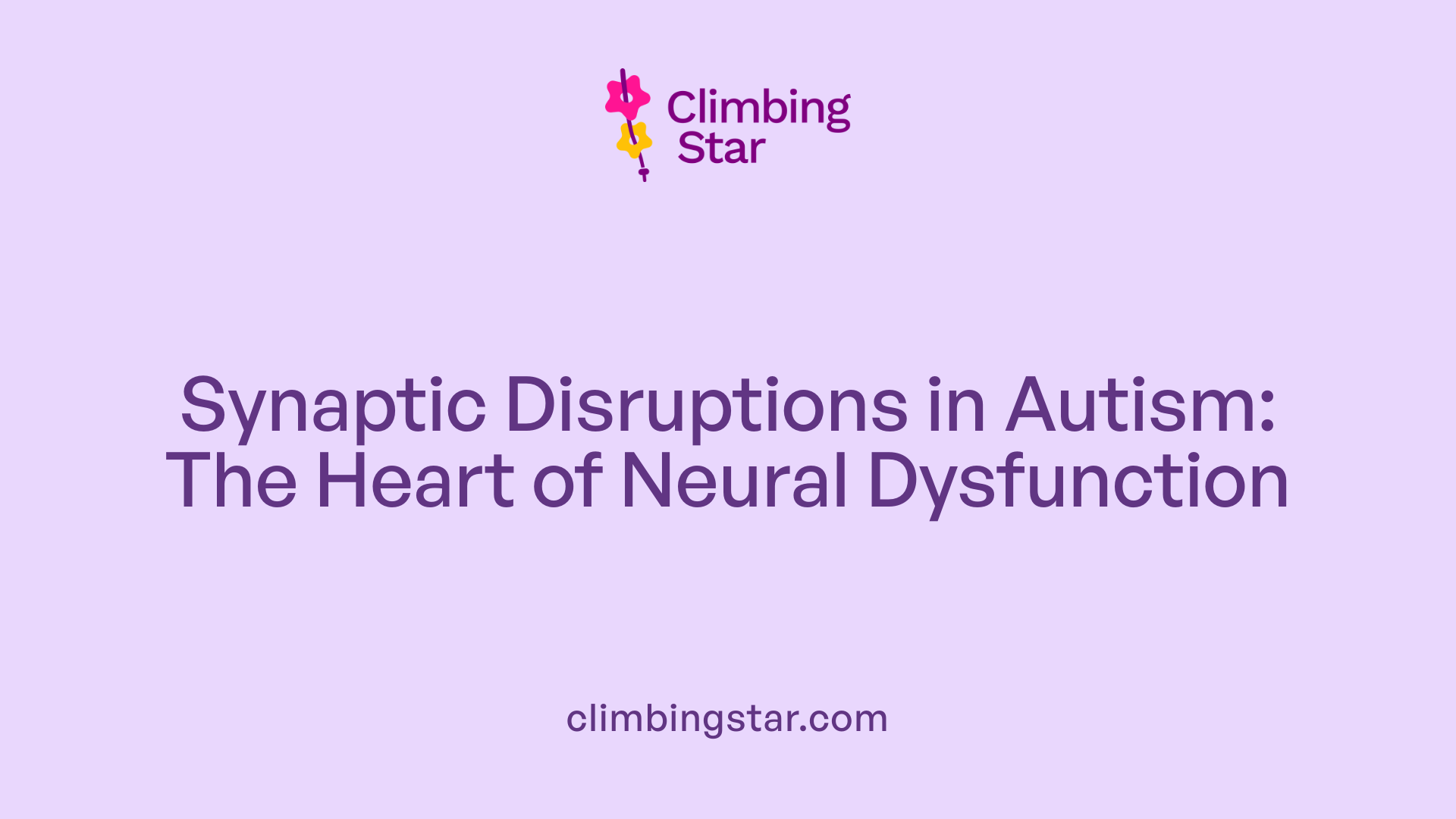
What are the Synaptic Targets in ASD?
Autism Spectrum Disorder significantly affects synapses, especially the postsynaptic sites found on dendrites. These locations are crucial for transmitting neural signals and processing information across brain circuits. Disruptions here directly influence the communication between neurons, which is fundamental to cognitive and sensory functions.
How is the Excitatory/Inhibitory Balance Disrupted in Autism?
In ASD, an imbalance occurs between excitatory and inhibitory signaling at synapses. This imbalance can stem from mutations affecting synaptic components, leading to excessive or insufficient neural excitation. Such disruption contributes to the abnormal neural network activity observed in individuals with autism, impacting behavior and sensory processing.
What Changes Occur in Dendritic Spine Structures?
Dendritic spines, the small protrusions receiving excitatory synaptic input, show significant alterations in ASD. Mutations in genes related to ASD cause changes in spine density, shape, and function. These structural abnormalities are hallmark features influencing cognition and sensory sensitivity, both critical in autism's neurodevelopmental profile.
How is Synaptic Transmission Impaired?
Mutations that affect chromatin remodeling complexes, notably those involving the ARID1B gene, reduce dendritic arborization and impair synaptic transmission. This impairment disrupts the efficiency of neurotransmitter release and reception, weakening neuronal connectivity and contributing to the symptoms of ASD.
What Role Does ARID1B and Other Mutations Play?
ARID1B has a pivotal role in neuron growth, dendritic development, and synaptic function. Mutations here and in other ASD-related genes influence molecular pathways controlling chromatin remodeling and gene expression. These changes hinder the proper formation and maintenance of synaptic structures, underlying many neural dysfunctions seen in autism.
Brain Morphology and Structural Abnormalities in Autism
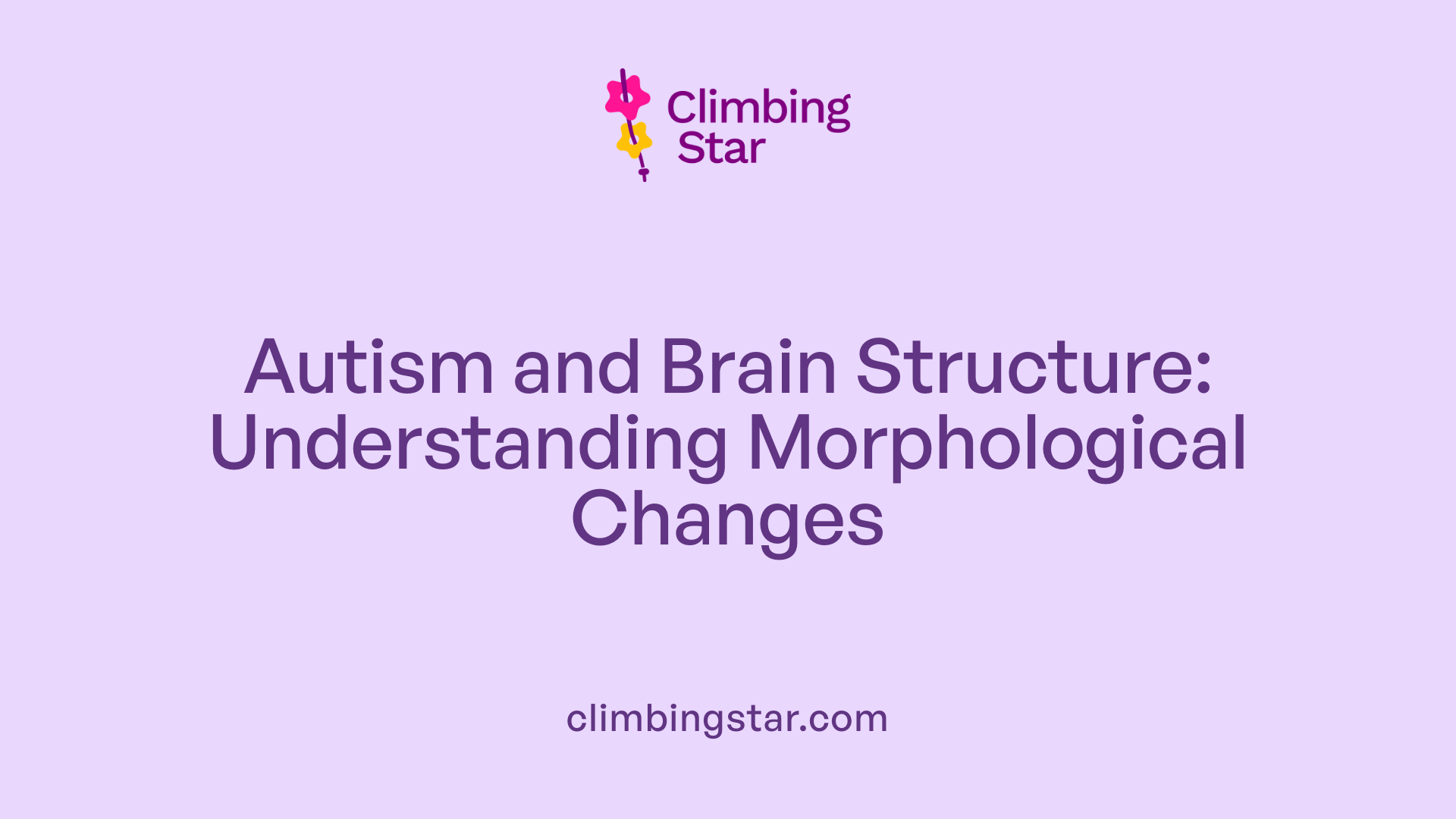
Increased Brain Volume Patterns in Children with ASD
Children with autism spectrum disorder often display increased total brain volume, particularly observable between ages 2 to 4. This early overgrowth predominantly affects the left hemisphere and involves both gray and white matter.
Gray and White Matter Variations
The increase in brain size arises from elevations in gray matter, which contains neuronal cell bodies, and white matter, composed of myelinated axons. These variations are significant neurobiological features linked to autism.
Cortical Disorganization and Minicolumn Abnormalities
Histopathological studies reveal that the cortex of individuals with ASD exhibits disorganization, including patches of altered cells. A notable finding is the presence of narrower but more numerous cortical minicolumns with reduced neuropil space, which may imply defects in cortical inhibition and interneuron function.
White Matter Overgrowth and Connectivity Disruption
White matter enlargement is particularly prominent in intrahemispheric corticocortical connections, especially within the frontal lobes. This abnormal growth disrupts neural connectivity and functional integration critical for complex processing.
Reduced Corpus Callosum Size
Conversely, interhemispheric white matter structures such as the corpus callosum tend to be reduced in size in ASD, suggesting compromised communication between brain hemispheres.
Developmental Trajectory of Brain Volume
Excessive brain growth in early life is typically followed by a slowing of volume increase during childhood and possible decline through adolescence and adulthood. Early overgrowth is thought to result from a surplus of neurons and synaptic connections formed prenatally, contributing to later morphological changes.
Molecular and Transcriptomic Changes: Insights from Brain-Wide Studies
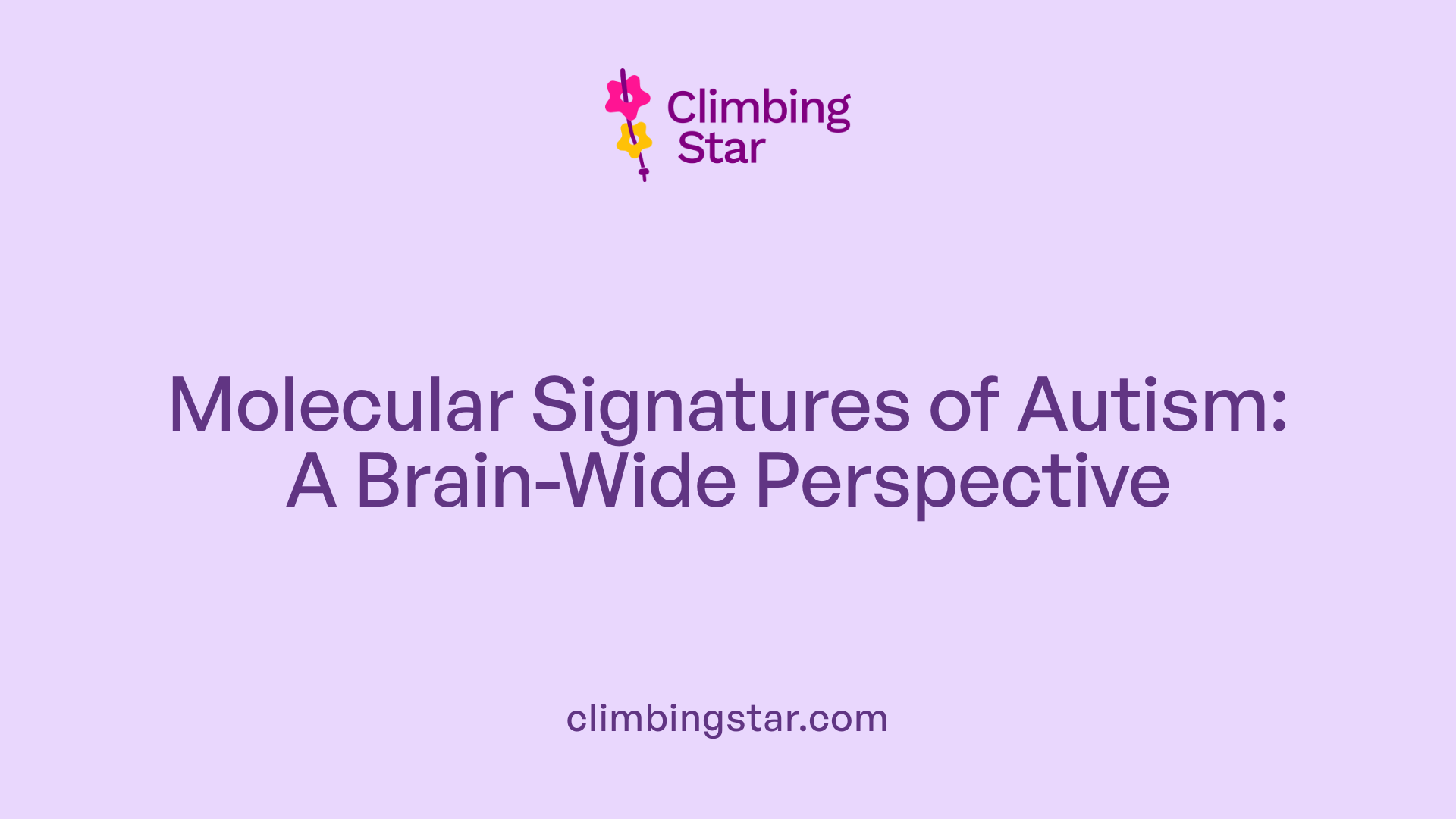
What gene expression alterations are observed across cortical regions in autism?
Autism Spectrum Disorder (ASD) causes extensive molecular changes throughout the brain's cortex, affecting 11 different regions with widespread gene expression alterations. Recent postmortem RNA sequencing studies have revealed these alterations are not confined to areas traditionally linked to social behavior and language but span multiple cortical regions.
Why are changes in the visual and parietal cortex significant in ASD?
The visual and parietal cortices show the most pronounced gene expression changes in individuals with ASD. These areas are crucial for sensory processing and integration, which may explain sensory hypersensitivity and difficulties often observed in autism. Alterations in gene expression here correlate with clinical features such as heightened sensitivity to stimuli.
How are neuron-expressed ASD risk genes affected?
Genes associated with increased autism risk, particularly those expressed in neurons, are consistently downregulated across the brain in ASD. This reduced expression suggests these molecular changes may be causal factors in autism rather than consequences, impacting neural communication and brain connectivity.
What does brain-wide molecular pathology reveal about autism?
The observed gene expression patterns reflect comprehensive molecular pathology in ASD, indicating that autism is not localized but involves brain-wide disruptions. This includes altered synapse function, neuronal development, and chromatin remodeling processes, affecting cognition and sensory functions across multiple cortical areas.
What potential exists for reversing gene expression abnormalities in autism?
Understanding these extensive molecular changes opens new avenues for targeted therapies. Future interventions might reverse or modulate gene expression abnormalities through emerging molecular strategies, aiming to restore typical neuronal network functioning and improve clinical outcomes.
| Topic | Description | Implication |
|---|---|---|
| Gene Expression Alterations | Brain-wide transcriptomic changes across 11 cortical regions in ASD | Demonstrates widespread molecular impact |
| Visual and Parietal Cortex Changes | Most significant gene expression differences correlate with sensory issues | Helps explain sensory hypersensitivity |
| Neuron-expressed ASD Risk Genes | Reduced expression suggests causality rather than consequence | Highlights targets for molecular therapies |
| Brain-wide Molecular Pathology | Reflects synaptic and developmental disruptions affecting multiple regions | Supports view of autism as a systemic brain disorder |
| Potential for Reversal | Opens pathway for therapeutic gene expression modulation | Promotes development of novel ASD treatments |
Functional Connectivity and Neural Network Disruptions Underlying Social and Cognitive Deficits
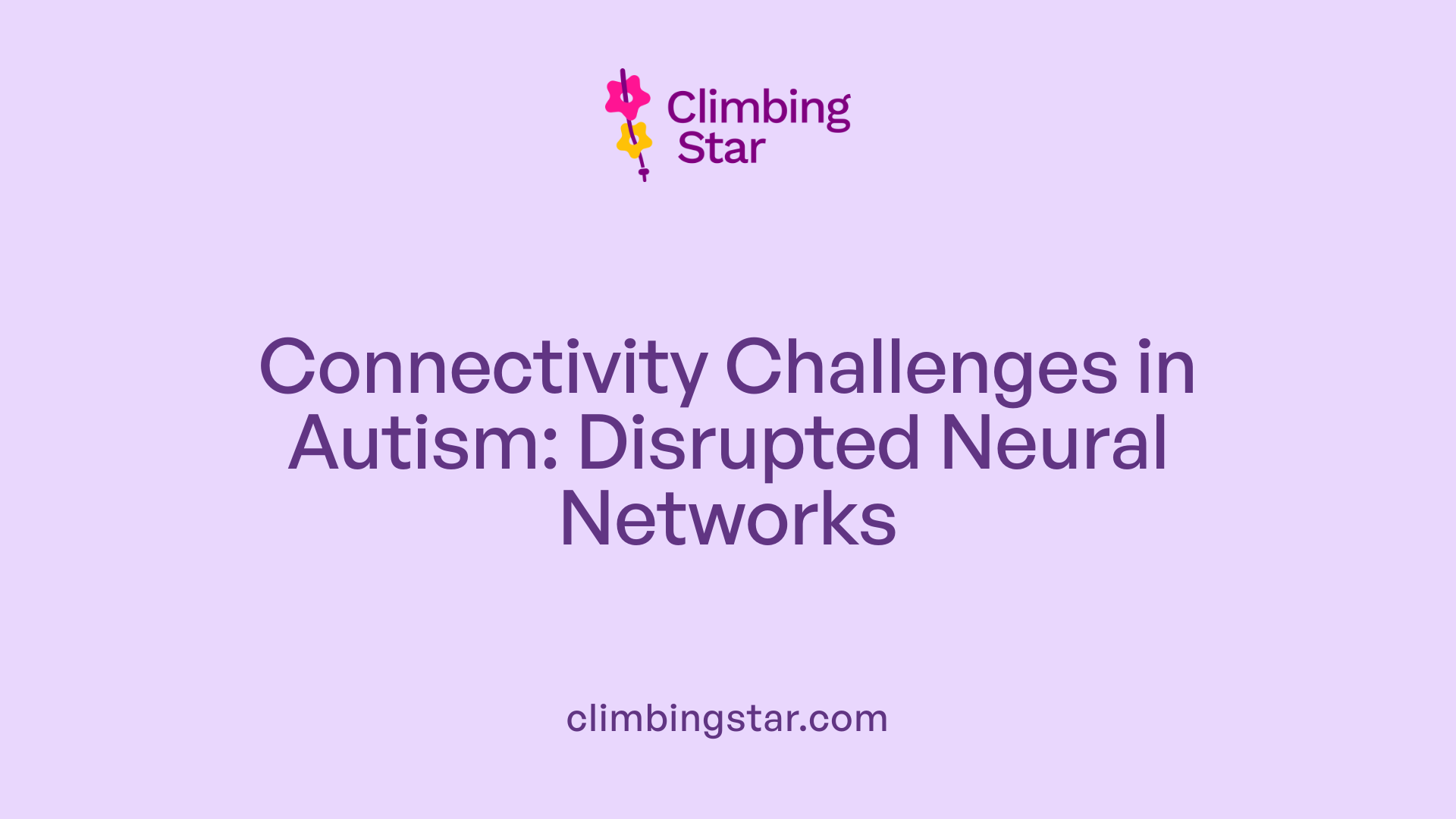
What alterations in connectivity are observed in autism?
Autism Spectrum Disorder (ASD) involves significant disruptions in brain connectivity, particularly in the association cortex. These disruptions mainly affect intrahemispheric corticocortical connections, especially within the frontal lobes, reducing the brain's efficiency in integrating information.
How are intrahemispheric corticocortical connections impacted?
Structural MRI studies have documented abnormalities such as overgrowth of white matter in the frontal lobes, indicating excessive but possibly disorganized neural pathways within the same hemisphere. Conversely, interhemispheric connections like the corpus callosum show size reductions, suggesting selective impairment.
What do functional MRI studies reveal about connectivity in ASD?
Resting-state and task-based functional MRI (fMRI) consistently show reduced functional connectivity within and between neocortical regions involved in language, social interaction, and cognitive processes. This disruption hampers network integration needed for complex social communication and sensory processing.
How do these connectivity changes affect social cognition and sensory functions?
Altered neural connections compromise the brain circuits responsible for social cognition and sensory integration, leading to difficulties in understanding social cues, interpreting emotional tones, and processing sensory stimuli. For example, over-connectivity in certain social brain regions can distort emotion recognition, while under-connectivity disrupts overall network coordination.
What insights have fMRI studies provided regarding these neural network alterations?
fMRI investigations have confirmed altered activation patterns during language and cognitive tasks, showing hypoactivation or compensatory hyperactivation in critical brain regions. These findings align with behavioral observations, such as impaired complex information processing and sensory sensitivities seen in ASD individuals.
| Aspect | Observations in ASD | Impact on Function |
|---|---|---|
| Association Cortex | Altered connectivity predominantly intrahemispheric | Disrupted integration of complex information |
| Frontal Lobe White Matter | Overgrowth with disorganized pathways | Impaired executive and social cognitive functions |
| Corpus Callosum | Reduced size | Diminished interhemispheric communication |
| Functional Connectivity | Reduced within/between networks in language/social areas | Difficulties with social interaction and language processing |
| fMRI Activation Patterns | Altered during tasks; hypo- or hyperactivation | Reflects compensatory changes or dysfunction in neural circuits |
Synaptic Density and Its Correlation with Autism Severity

Use of PET Scan with 11C-UCB-J Radiotracer
A breakthrough in measuring synaptic density in living humans has been achieved through a novel PET scan technique using the radiotracer 11C-UCB-J. This advanced imaging method allows researchers to directly observe synaptic density in the brain, providing unprecedented insight into neural connectivity in autism spectrum disorder (ASD).
Findings of Reduced Synaptic Density in Autistic Adults
Studies using 11C-UCB-J PET scans reveal that autistic adults exhibit a 17% reduction in synaptic density across the brain compared to neurotypical adults. This widespread decrease highlights a significant structural difference and supports the understanding that synaptic abnormalities are a core aspect of ASD pathology.
Relationship Between Synaptic Deficits and Core Autism Features
Lower synaptic density correlates strongly with increased severity of autistic traits. Critical symptoms such as social-communication difficulties, including diminished eye contact and challenges recognizing social cues, are linked to these synaptic deficits. Moreover, repetitive behaviors commonly observed in ASD also relate to the observed reduction in synaptic connections.
Biological Links to Social-Communication Difficulties and Repetitive Behaviors
By establishing a direct biological basis for core autism features, the reduction in synaptic density bridges the gap between genetic and molecular changes and the behavioral manifestations of ASD. This connection enhances our understanding of how synaptic imbalance disrupts brain function essential for social interaction and behavioral flexibility.
Implications for Diagnosis and Treatment
These findings pave the way for improved diagnostic approaches by providing a biological marker measurable in living individuals. Additionally, they open new avenues for therapeutic strategies focused on restoring synaptic health and maintaining excitatory/inhibitory balance, offering hope for interventions tailored to individual neural profiles in autism.
Neuroinflammation, Immune Dysfunction, and Aging in the Autistic Brain

Increased expression of heat-shock proteins in autism
Studies have found that brains of individuals with autism show elevated mRNA levels for heat-shock proteins. These proteins typically respond to cellular stress and are markers of increased immune activity and inflammation within brain tissues.
Upregulated inflammation-related genes
Gene expression analyses of autistic brain tissues reveal strong upregulation of genes involved in inflammation and immune responses. This heightened inflammatory environment may worsen over time, potentially driving progressive neurological changes.
Altered immune response in autism
The autistic brain displays signs of immune dysfunction, with inflammation-related gene patterns differing markedly from neurotypical brains. Such immune irregularities could contribute to synaptic and neuronal dysfunction observed in autism spectrum disorder (ASD).
Age-dependent gene expression changes
Age influences gene expression in autism differently than in controls. For example, the gene HTRA2 shows decreased expression in autistic brains during youth but increases with aging, hinting at altered neuronal function and possible premature aging processes.
In addition, there is a noted decline in genes responsible for GABA synthesis in ASD with age, potentially impacting inhibitory neurotransmission and contributing to neurological symptoms.
Similarities with neurodegenerative conditions like Alzheimer’s
Research shows molecular parallels between autism and Alzheimer’s disease in the superior temporal gyrus, a key brain region for social perception and language. Shared gene expression patterns suggest autistic brains may have increased vulnerability to neurodegenerative changes as they age.
Understanding these molecular and immune mechanisms across the autistic lifespan will be critical to developing effective early interventions and treatments that address both developmental and aging-related challenges in ASD.
Functional Brain Differences Affecting Emotional Recognition and Social Interaction in Children

What is the role of the temporoparietal junction in autism?
The temporoparietal junction (TPJ) is a crucial region within the social brain network, responsible for decoding emotional tones and social cues. In children with autism, differences in wiring and function of the TPJ significantly affect their ability to identify emotional information in voices.
How does brain activity change in response to emotional voices in children with autism?
Functional MRI (fMRI) studies reveal that children with autism show typical auditory responses but exhibit altered activity and increased connectivity specifically in the TPJ. This alteration is especially prominent when processing sad vocal emotions, indicating an over-connection in this social brain region.
How do these brain differences correlate with social communication difficulties?
The altered activity and connectivity in the TPJ directly relate to the severity of social communication challenges. Children with autism who display greater differences in TPJ responses tend to have more pronounced difficulties in social interaction, including trouble understanding emotional speech and interpreting social cues.
What are the potential targets for brain-based therapies?
The findings suggest that therapies aiming to remap or strengthen the TPJ's function could improve social communication skills. Such interventions may utilize game-like or brain-training methods focused on enhancing the decoding of emotional speech, particularly targeting the neural circuitry of the temporoparietal junction.
How are fMRI and behavioral assessments used in this research?
Researchers combine fMRI scans with behavioral tasks that test emotion recognition from voice recordings. This approach helps identify the neural underpinnings of social deficits by linking brain activity patterns directly to behavioral performance in children with autism.
These insights into the TPJ's role offer promising avenues for developing targeted therapies that address the complex social communication difficulties experienced by children on the autism spectrum.
Behavioral Therapy and Its Neurological Correlates in Autism Treatment
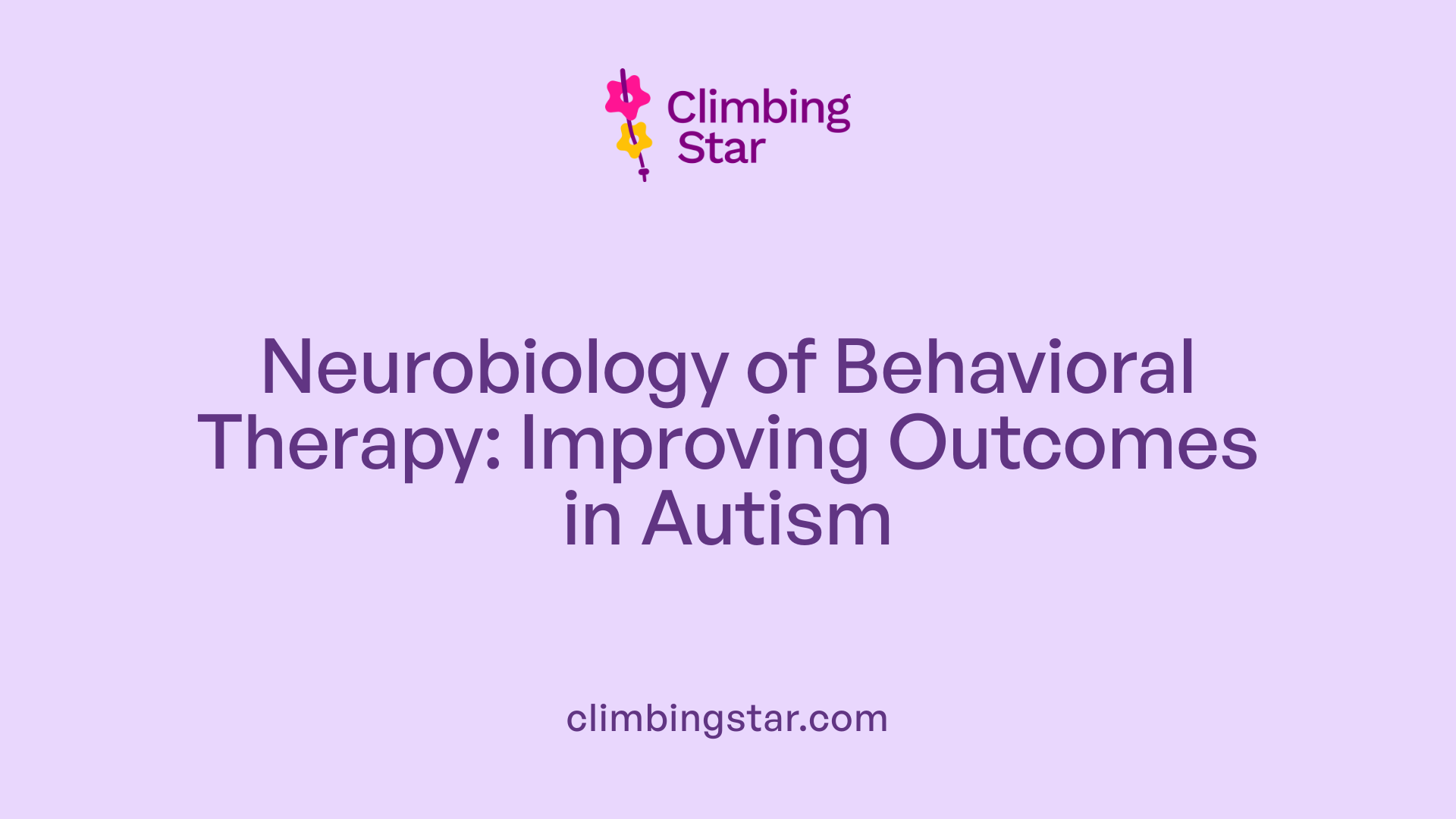
What is therapy focusing on autism and behavioral analysis?
Behavioral therapy for autism spectrum disorder (ASD) chiefly involves Applied Behavior Analysis (ABA). ABA is an evidence-based intervention designed to enhance social communication, daily living skills, and reduce challenging behaviors. It uses the "A-B-C" model — antecedent, behavior, consequence — to understand and modify behaviors.
Applied Behavior Analysis (ABA) overview
ABA employs multiple techniques such as positive reinforcement, prompting, modeling, and systematic data collection. Interventions are personalized and delivered under the guidance of a trained professional, typically a Board Certified Behavior Analyst (BCBA). ABA integrates structured approaches like Discrete Trial Training (DTT) and naturalistic strategies such as Pivotal Response Treatment (PRT). The therapy is conducted across various environments, including home and community settings.
Neuroscience integration with behavioral interventions
Recent research advocates combining neuroscience with behavioral therapies to measure brain changes resulting from intervention. This integration aims to better understand how behavioral treatments influence neurological functions and connectivity in individuals with ASD.
Evidence for brain changes induced by therapy
While behavioral interventions like ABA are well-established, studies directly examining neurological responses to these therapies are limited. Existing evidence suggests that brain circuits involved in social communication and emotional processing may show altered activity patterns after therapy, implicating brain plasticity in behavioral improvements.
Importance of early intensive intervention
Early, intensive behavioral intervention is critical to maximizing gains. Brain development in children with autism is dynamic, and timely therapies can modulate neural pathways to improve social skills and reduce symptoms.
Current gaps in research on neurological responses
Despite promising concepts, there is a notable scarcity of comprehensive studies exploring how behavioral therapies induce lasting neurological changes. More rigorous research is needed to connect behavioral outcomes with specific brain alterations, which could advance personalized treatment strategies in ASD.
Future Directions: Toward Biomarkers and Personalized Interventions for Autism

What challenges remain in understanding ASD genetics and neurobiology?
Despite remarkable progress, the complexity of ASD genetics and neurobiological mechanisms continues to pose significant challenges. With over 800 associated genes and intricate epigenetic regulation affecting brain development, it is difficult to pinpoint causative pathways. Moreover, ASD involves widespread molecular alterations across the brain's cortical regions, not confined to social or language areas. Variations in brain morphology and connectivity further complicate understanding, as do the multiple phenotypic presentations across the spectrum.
Why is there a pressing need for reliable biomarkers?
Reliable biomarkers are critical to enhance ASD diagnosis, especially early in life when interventions are most effective. Current ASD diagnoses hinge largely on behavioral assessments, which can be subjective and delayed. Biological markers, such as synaptic density measures using advanced PET imaging or gene expression profiles from postmortem studies, could help objectively identify subtypes within the spectrum. This stratification would facilitate tailored therapies and improve clinical outcomes.
How might molecular findings shape targeted therapies?
Advances in understanding gene expression abnormalities and synaptic disruptions open avenues for new treatments. For example, mutations in chromatin remodeling genes like ARID1B and genes regulating excitatory/inhibitory balance suggest potential targets for pharmacological intervention to restore neural connectivity. Therapies could aim to modulate specific molecular pathways, correct gene expression, or rebalance synaptic activity. Moreover, protocols aimed at enhancing cortical inhibition or targeting social brain circuitry, such as the temporoparietal junction, hold promise for improving social communication.
What is the role of multimodal imaging and genomic approaches?
Combining neuroimaging techniques such as functional MRI, PET scans, and structural MRI with genomics enriches our understanding of ASD brain-behavior relationships. Imaging genetics approaches link specific gene variants to brain network alterations, shedding light on mechanisms driving social and cognitive deficits. Employing these complementary technologies across developmental stages can uncover diverse neural signatures and biological subtypes, guiding precision medicine strategies.
Why consider developmental and lifespan perspectives?
ASD is a neurodevelopmental disorder with brain and molecular changes evolving from childhood through adulthood. Early brain overgrowth is followed by altered connectivity and possible neurodegenerative trends in aging autistic individuals. Gene expression patterns linked to inflammation and neural aging further emphasize the dynamic nature of ASD. Understanding these temporal trajectories is essential for designing age-appropriate interventions and monitoring long-term outcomes.
Together, these future directions point toward a convergence of genomic insights, advanced brain imaging, and developmental science to establish robust biomarkers and devise personalized, biologically informed interventions for autism.
Towards a Deeper Understanding of Autism's Neural Landscape
The intricate interplay of genetic, epigenetic, molecular, and structural brain changes defines the complex neurobiology of Autism Spectrum Disorder. From synaptic dysfunction and altered connectivity to immune-related inflammation and atypical brain development, autism impacts the brain on multiple levels, shaping its manifestations and challenges. Behavioral therapies such as Applied Behavior Analysis remain critical, dovetailing with emerging neuroscience insights to forge a path toward personalized interventions. Continued multidisciplinary research promises to deepen our understanding of autism's effects on the brain, ultimately enhancing diagnostic precision and treatment efficacy for individuals across the spectrum.
References
- Autism Spectrum Disorder: Brain Areas Involved ...
- A Key Brain Difference Linked to Autism Is Found for the First ...
- Neurobiological basis of autism spectrum disorder
- Brain changes in autism are far more sweeping than ...
- Brain wiring explains why autism hinders grasp of vocal ...
- The New Neurobiology of Autism - PubMed Central - NIH
- Using neuroscience as an outcome measure for behavioral ...
- UC Davis study uncovers age-related brain differences in ...
- Genetics of structural and functional brain changes in ...
- Applied Behavior Analysis (ABA)







